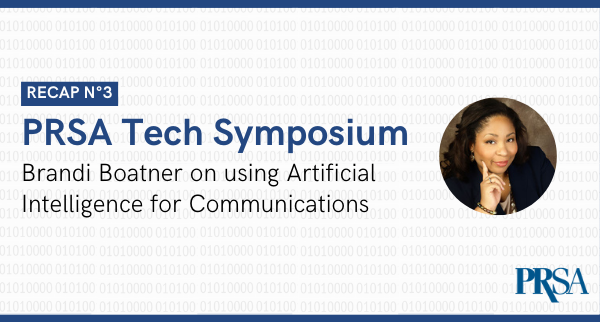
Brandi Boatner, Manager of Digital & Advocacy Communications at IBM, delivered her session “Next Gen PR – Using Artificial Intelligence for Communications” to close the Technology Symposium as part of PRSA ICON 2020 virtual conference. The 2021 Chair Elect of the Tech Section covered the concepts of Artificial Intelligence (AI), its role in PR, and she also explained how to build an AI newsroom chatbot to answer media questions.
The session started with an overview of AI history: Alan Turing asking his question “Can Machines Think?” in 1950, and the IBM Pavilion at the 1964 World’s Fair as an early incarnation of the industry’s and business’ drive to automate tasks.
Boatner then made a difference between consumer computing and enterprise computing. While the consumer world is about “mimicking speech, vision, and daily interactions,” she said, enterprise computing “is mimicking and improving enterprise functions such as logistics, marketing, finance, operations, and HR. Enterprise AI is about solving sophisticated business problems in highly dynamic environments,” Boatner explained.
Can Machines Learn?
At its core, AI is about how the machine learns: “You have probably heard the term machine learning, and that's what AI is about. It is how the machine learns, and the machine only learns if you feed it data.” To fully leverage AI, Boatner said, we must also understand how to adopt and implement the technology.
Boatner then explained how digitized data is everywhere, and growing in volume every day, from 500 million tweets and 300 billion emails sent, to 70 billion WhatsApp messages and close to 5 billion searches. With such a large volume of textual data created every day, there are countless insights that can be extracted to make critical decisions in almost any industry or business. For example, news articles, financial reports, and other content sources can be compiled and analyzed for sentiment around company stocks. All of this is possible with the help of natural language processing (NLP). “NLP is a massive space within artificial intelligence (AI), and enterprises are currently integrating NLP technologies into their existing platforms every day,” Boatner said.
Augmented Intelligence
Boatner also explained the concept of “Augmented Intelligence” as it applies to communications, and how this is a blend of technology and human insight sprinkled with emotional intelligence. “Few forms of communication are as persuasive as a compelling narrative. Let the data augment your intelligence as a modern communicator so you can captivate the audience’s attention,” Boatner said.
“As PR professionals and communicators, we have a job to educate, persuade and inform on the full range of issues where new technologies continue to change the way humans interact with each other,” Boatner said. “Marketing and public relations professionals that adopt analytics capabilities can discover what is happening, determine why it is happening, predict what is likely to happen, and prescribe the best actions to take.”
Boatner then presented some use scenarios for AI in communications, showing how PR professionals could make more processes better targeted with smarter and more accurate analysis. For example, Boatner said, “What if you could create hyper-relevant personalized messages to influencers instead of the generic pitch? PR professionals could use AI and NLP to craft the pitch and find out what to write in the pitch.”
How To Train Your Chatbot
“Whether it’s answering questions for online shoppers, assisting customers file their taxes, or helping people understand their insurance policies, chatbots are enhancing experiences today more than ever. But the experiences that you choose to enhance are entirely up to you,” Boatner said.
She then explained how to build a “Task chatbot” in four steps:
- Step 1: Define Intent. “The intents would answer 'where did you x', 'what is your y' and 'when did you z'. After you have your intents, the next step is to add utterances, or the way you ask the questions.”
- Step 2: Define entities. “The best way to think about entities is that they are the subjects of intents,” she explained. “So, in 'where did you go to college' the intent would be 'where' and the entity would be 'college'.”
- Step 3: Create your Dialog. “Setting up your dialog flow is all about logic. Each intent begins a node on the left and the logic flows from top to bottom through your intents. If a certain intent is triggered by an utterance, its node is opened, and the logic continues to entities.”
- Step 4: Training & Improving. “Then it’s time to deploy your bot to some friends and family to see how it does. I can’t stress enough how important it is to deploy your bot ASAP so you can see how your bot handles questions.”
Join the PRSA Tech Section for more industry updates just for members.